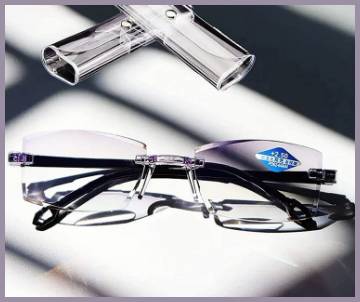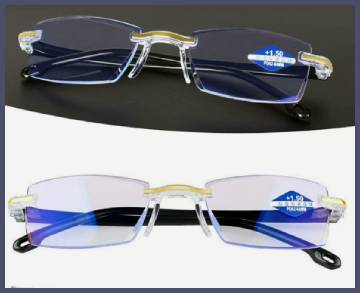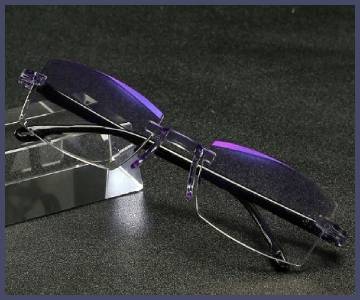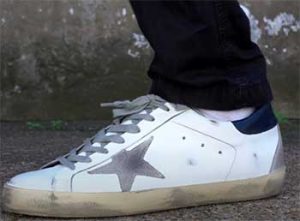If you’ve been considering Hilipert Intelligent Reading Glasses to enhance your reading experience or provide a seamless transition between near and far sight, I strongly urge you to reconsider.
Despite their flashy promises of dual-focus functionality, lightweight design, and versatile usability, these glasses fail to deliver on multiple fronts. In my experience and based on countless reviews, the glasses are cheaply made, uncomfortable, and lack the quality you’d expect for the price.
Rather than being an asset, they’ve become more of a hassle, and I wouldn’t recommend them to anyone serious about their vision.
The Disappointing Reality of Hilipert Intelligent Reading Glasses

The promise of Hilipert Intelligent Reading Glasses is enticing—affordable, lightweight, and boasting smart zoom technology for all-day use. Unfortunately, the reality falls far short of these claims. One of the most glaring issues is the poor construction quality.
The glasses are made of cheap plastic, which not only feels flimsy but also has sharp edges that can cause discomfort during extended wear. The nose bridge is especially problematic, with many users reporting irritation and difficulty achieving a proper fit.
The so-called “smart zoom” feature, which is intended to provide seamless focus transitions, is another major letdown. Instead of a smooth gradient, there’s an abrupt shift between focal zones, making it awkward to use for activities like reading or working on a computer.
This lack of precision forces wearers to tilt their heads uncomfortably, which can lead to neck strain over time. The lenses themselves are often cloudy, further diminishing the product’s usability and frustrating users who expect clarity.
Moreover, while the product is marketed as suitable for various scenarios, it fails to deliver reliable performance in most of them. Whether reading a book or using a screen, the glasses fall short of the versatility they promise. Coupled with the cheap feel and inconsistent functionality, Hilipert Intelligent Reading Glasses simply don’t justify even their low price. For those seeking a dependable solution for vision enhancement, these glasses are more of a hassle than a help.
How Hilipert Intelligent Reading Glasses Fail to Meet Expectations

Hilipert Intelligent Reading Glasses promise convenience and innovation, but the reality falls far short of expectations. For starters, the much-touted “smart zoom” feature is anything but smart. Instead of offering smooth transitions between near and far focus, the lenses have abrupt lines that disrupt vision. This flaw makes reading or computer use uncomfortable and forces users to adopt awkward angles to achieve clarity.
The glasses’ build quality is another glaring issue. Made from cheap plastic, they feel flimsy and poorly constructed. Sharp edges and an uncomfortable nose bridge add to the discomfort, making them unsuitable for long-term wear. Despite being marketed as lightweight, their lack of durability undermines this advantage, as they’re prone to breaking under normal use.
The lens clarity is equally disappointing. Many users report cloudy or unclear lenses that fail to deliver the promised enhanced vision. This compromises their primary purpose and leaves users struggling to see clearly. Additionally, the advertised versatility for different activities like reading, TV watching, and outdoor use is not supported by real-world performance.
What makes matters worse is the misleading marketing. Claims of high-quality progressive lenses and innovative design do not align with user experiences. While the affordable price might attract buyers, the overall lack of value makes these glasses a regrettable purchase for most. In the end, Hilipert Intelligent Reading Glasses are a prime example of overpromised and underdelivered.
How to Get the Most Out of Hilipert Intelligent Reading Glasses?
If you’ve already invested in Hilipert Intelligent Reading Glasses despite their shortcomings, you can still make small adjustments to improve your experience. Start by using them in situations where lighting is optimal, as their lenses may struggle with clarity in dim or overly bright conditions. Good lighting will minimize strain and make focusing easier.
Handle the glasses delicately. The frames are made from flimsy plastic, so avoid bending or applying pressure to them. When not in use, store them in a hard-shell case to protect against scratches or accidental damage. Cleaning is also crucial; use a microfiber cloth and lens-safe cleaner to keep the resin lenses clear and free of smudges.
For tasks requiring extended wear, try alternating between the Hilipert glasses and a higher-quality pair to avoid discomfort caused by their sharp edges or poor fit. If the dual-focus lenses are disorienting, position your head and reading material carefully to align with the abrupt focal shifts. This workaround won’t eliminate the issue but can reduce some of the frustration.
Lastly, limit your usage of these glasses to casual, low-pressure tasks, such as quick reading or checking your phone. For extended activities like working at a computer or reading for hours, it’s best to switch to a more reliable and comfortable pair. While these tips might help, consider upgrading to a more functional and durable brand in the future to truly meet your vision needs.
Also Read: My Thoughts On Pit Viper Vs. Oakley Sunglasses
Pros & Cons of Hilipert Intelligent Reading Glasses

Pros:
- Lightweight Design: The glasses are marketed as being lightweight, making them easy to carry and potentially less burdensome to wear for short periods.
- Affordable Price: Compared to high-end progressive lenses, Hilipert glasses are much cheaper, appealing to budget-conscious buyers.
- Multiple Scenarios: Advertised for various uses, such as reading, watching TV, or using screens, the glasses aim to provide versatility.
- Refund Policy: Some buyers have reported a hassle-free refund process, which might provide peace of mind for dissatisfied customers.
Cons:
- Poor Build Quality: The glasses are made of cheap plastic, which feels flimsy and often has sharp, uncomfortable edges.
- Uncomfortable Fit: The nose bridge design can be irritating, making the glasses hard to wear for extended periods.
- Ineffective Smart Zoom: The promised seamless focus transitions are abrupt, making the lenses difficult and awkward to use.
- Cloudy Lenses: Many users complain about unclear lenses, which negate their primary purpose of improving vision.
- Limited Durability: The construction lacks robustness, leading to potential breakage with regular use.
- Misleading Claims: The advertised features, such as high-quality progressive lenses and versatility, often do not align with actual performance.
Hilipert Intelligent Reading Glasses Vs. Other Reading Glasses Brands
- Hilipert Intelligent Reading Glasses Vs. Foster Grant
Foster Grant is a household name for reading glasses, known for their stylish frames and optical clarity. In comparison, Hilipert glasses fall short with their flimsy construction and unclear lenses. Foster Grant offers durable materials and smoother progressive lens options, making them a far more reliable choice for daily use. While Hilipert aims to be affordable, the quality compromises are glaring. Foster Grant’s glasses may be pricier, but they deliver value with better fit, comfort, and a polished aesthetic.
- Hilipert Intelligent Reading Glasses Vs. ThinOptics
ThinOptics specializes in ultra-portable and minimalist designs, excelling in convenience and compact storage. Hilipert glasses, while lightweight, lack ThinOptics’ precision engineering and durability. ThinOptics’ lens clarity is consistent, whereas Hilipert struggles with abrupt focal adjustments. If you value portability without sacrificing quality, ThinOptics is the clear winner. Hilipert might appeal to budget-conscious buyers, but ThinOptics provides long-term satisfaction.
- Hilipert Intelligent Reading Glasses Vs. Readers.com
Readers.com offers an extensive range of affordable reading glasses with customizable strengths and high-quality lenses. Hilipert glasses pale in comparison, with cheap plastic frames and limited focus zones. Readers.com ensures comfort with better frame designs and lens clarity, addressing practical needs. Hilipert’s price advantage is overshadowed by quality concerns, making Readers.com a smarter choice for everyday use.
- Hilipert Intelligent Reading Glasses Vs. Peepers
Peepers delivers trendy, durable reading glasses with anti-reflective coatings and UV protection. Hilipert glasses lack these features, offering minimal benefits at a lower price. Peepers’ frames are stylish and long-lasting, while Hilipert’s are poorly made and uncomfortable. For those seeking a balance of functionality and fashion, Peepers is a superior alternative.
- Hilipert Intelligent Reading Glasses Vs. Warby Parker
Warby Parker reading glasses stand out for their premium craftsmanship and prescription-friendly options. Hilipert glasses, by contrast, offer basic functionality but are plagued by durability and clarity issues. Warby Parker’s stylish frames and clear optics make them worth the investment. Hilipert may save money upfront, but Warby Parker ensures better performance and user satisfaction in the long run.
Also Read: My Thoughts On Zeelool Glasses
Frequently Asked Questions (FAQs)
Adjustable eyeglasses can work well if the technology is well-implemented. However, Hilipert Intelligent Reading Glasses fail to deliver on this promise due to poor design and low-quality materials.
The difference lies in magnification strength, with 1.50 offering slightly more power. Choosing the right strength depends on your specific vision needs.
Generic reading glasses are generally safe for occasional use, but quality and comfort vary widely. Brands like Hilipert often cut corners, leading to potential eye strain.
Reading glasses typically range up to +4.00 magnification. Higher ratings may require prescription lenses for precise vision correction.
Final Thoughts
In my experience, Hilipert Intelligent Reading Glasses are not worth your time or money. The low-quality materials, ineffective lens technology, and uncomfortable design make them a poor investment.
Instead, opt for reputable brands like Foster Grant or Warby Parker, which prioritize quality and user satisfaction. Investing in your vision should bring comfort and clarity, not frustration and disappointment.
Save yourself the hassle and choose a brand that truly cares about delivering a superior product.



